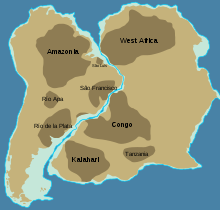List of named cratons


Listed by modern continent and Gondwana, include:
West Gondwana
South America
- Amazonian Craton
- Guiana Shield
- Amazonian Shield
- São Francisco Craton (Congo Craton)
- Rio Apa Craton
- Río de la Plata Craton
- Arequipa–Antofalla Craton
- São Luís cratonic fragment
- Luís Alves cratonic fragment
Africa
- West African Craton
- East Saharan Meta-craton
- Congo Craton, central southern Africa
- Tanzanian Craton
- Kalahari Craton
- Kaapvaal Craton, South Africa (3.6–2.5 Ga)
- Zimbabwe Craton (3.5 Ga)
- Sebakwe Craton
Antarctic-East African Orogen
- Arabian Plate
- Part of the Arabian–Nubian Shield
- Western Ethiopian Shield
- Eastern Ethiopian Shield (part of the Somali Plate)
- Part of Madagascar
East Gondwana
Indian Subcontinent
Antarctica

Australia
- Altjawarra Craton
- Central Craton
- Curnamona Craton, South Australia
- Gawler Craton, central South Australia
- Pilbara Craton, Western Australia
- Yilgarn Craton, Western Australia (4.4 Ga)
North America


North American Craton
Deformed craton
Accretionary belt
- Canadian Shield (or Laurentian Shield)
- Churchill Craton
- Hearne Craton
- Nain Craton (part of North Atlantic Craton)
- North American Craton (Laurentia)
- Rae Craton
- Sask Craton
- Sclavia Craton
- Slave Craton, Northwest Territories, Canada (4.03–3.5 Ga)
- Superior Craton, Canada and northern United States (3.7–2.7 Ga)
- Wyoming Craton
Eurasia
Eastern Eurasia
- East China Craton [ citation needed ]
- North China Craton (sometimes called Sino-Korean Craton), (2.5 Ga)
- South China Craton (also known as Yangtze Craton)
- Siberian Craton, sometimes called Angara Craton.
- Tarim Craton, China
Northern and Eastern Europe
- East European Craton, the core of Baltica
- Volgo-Uralian Craton, Russia (3.0–2.7 Ga)
- Baltic Shield, part of the East European Craton; Fennoscandian Shield, the exposed Northwestern part of the Baltic Shield in Norway, Sweden and Finland (3.1 Ga)
- Karelian Craton, part of the Fennoscandian Shield in Southeast Finland and Karelia Russia, (3.4 Ga)
- Kola Craton, part of the Fennoscandian Shield, Kola Peninsula, Northwest Russia
- Belomorian Craton, part of the Fennoscandian Shield, between the Karelian and Kola cratons
- Sarmatian Craton (3.7–2.8 Ga)
- Midlands Microcraton of England and Wales
- North Atlantic Craton